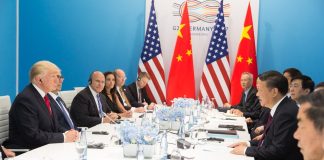Japan’s new prime minister, Sanae Takaichi, meets US President Donald Trump in Tokyo on Tuesday, in her first leader-level engagement since taking office on 21 October.
The encounter follows Trump’s audience with Emperor Naruhito and comes between Takaichi’s debut on the ASEAN circuit and this week’s APEC leaders’ meeting in South Korea, placing the US-Japan alliance at the centre of her early foreign policy.
Takaichi’s elevation as Japan’s first female prime minister has been framed domestically by a pledge to accelerate defence spending and by early efforts to steady relations with key partners. In her first policy speech, she said Japan would bring forward its target of lifting defence expenditure to 2% of GDP to the current fiscal year ending March 2026, two years earlier than previously planned. The move aligns with assessments in recent defence reviews that identify China as Japan’s principal strategic challenge and underline tensions around Taiwan and the East China Sea.
The meeting in Tokyo will test whether both sides can signal continuity on security while managing trade frictions. Since returning to office, Trump has pursued a more assertive tariff policy, including toward allies. Japanese officials have sought clarity on scope and implementation of any measures affecting autos and manufactured goods, amid a broader push to protect supply chains in critical sectors. The leaders’ agenda is also expected to cover alliance roles, regional deterrence and economic coordination ahead of APEC.
Energy security remains a sensitive point. Japan continues to import liquefied natural gas from Russia’s Sakhalin-2 project, a legacy exposure that Tokyo argues cannot be unwound abruptly without risking domestic supply and price stability. Washington has pressed partners to reduce purchases of Russian energy; Japan’s industry minister has said any shift must balance sanctions policy with national needs. Any reference to diversification in the leaders’ read-out will be closely watched by utilities and heavy industry.
Protocol and signalling matter in this first encounter. Trump’s arrival in Japan on Monday and the palace programme underscore the importance both capitals attach to optics as well as substance. Takaichi has already spoken to Trump by telephone, stressing that the alliance is “paramount”; Tuesday’s bilateral offers an opportunity to translate that line into concrete steps on defence timelines and economic coordination.
Regionally, the backdrop is mixed. Maritime activity by Chinese vessels around the Senkaku/Diaoyu Islands has persisted, and both Tokyo and Washington have emphasised deterrence in the Taiwan Strait. At the same time, the United States has encouraged tighter trilateral coordination among itself, Japan and South Korea. With APEC hosted in South Korea this year, Takaichi’s handling of summit diplomacy will help shape perceptions of Japan’s approach to coalition-building in the Indo-Pacific.
Domestic politics set constraints. Takaichi took office after a period of turbulence for the Liberal Democratic Party and has sought to project steadiness through experienced appointments and a clear defence timetable. The durability of early public support will depend in part on whether her government can finance higher defence outlays while managing a weak yen and cost pressures at home. Markets rallied on expectations of fiscal support and policy clarity, but the sustainability of that optimism will turn on delivery.



